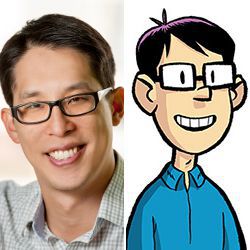
During fifth grade, Gene Luen Yang discovered two seemingly independent life passions: programming computers, and drawing comic books. He has pursued these two activities in parallel ever since, teaching high school computer science by day and writing award-winning graphic novels by night. "Comics and coding felt like two separate worlds," he has written.
Recently, however, Yang has figured out how to interweave the two in the form of a graphic novel series called Secret Coders, which introduces elementary school students to the joys of coding. Yang's body of work — which includes Superman comics and graphic novels that reflect on his Chinese heritage and history — earned him a MacArthur Fellowship earlier this year.
Yang, now 43, found his way into STEM-related comics when he was asked to serve as a long-term substitute teacher for an Algebra 2 class at Bishop O'Dowd High School in Oakland, where he taught computer programming from 1998 to 2015. At the time, Yang was also the school's director of information services, a role that forced him to miss several days of algebra class each month. To maintain continuity for his students, he started videotaping lectures to be played in his absence, but these lectures were a disaster, Yang said; "the students complained that they were shockingly boring."
As a "desperate second attempt," Yang started writing lectures in comic book format. To his astonishment, his students couldn't get enough of them. "They asked me to make them even when I could be in class in person."
As with computer programming, many of the algebra problems were highly algorithmic, with a strong visual component. "For material like that, I think seeing it as a sequence of pictures really helps," Yang said. Some of the ideas he developed during the course eventually became part of his master's thesis at California State University, East Bay, for which he created an online comic tutorial called Factoring with Mr. Yang & Mosley the Alien.
Meanwhile, Yang's second career as a graphic novelist was taking off: his 2006 novel American Born Chinese, for example, received multiple awards and honors and was the first graphic novel to be a finalist for the National Book Award. As Yang continued to write graphic novels and comics, he started mulling over the notion of writing a graphic novel series about computer programming.
That idea turned into reality late last year, when the first volume of Secret Coders was published. A second book in the series, called Paths and Portals, appeared in August, and four more books are in the works.
The books feature 12-year-old Hopper (named after the influential early programmer Grace Murray Hopper) who, together with her friends and a mysterious school janitor, encounters a collection of turtle-shaped robots who carry out increasingly complicated programs written in Logo — the language Yang himself learned in fifth grade. A companion website helps readers download a Logo interpreter so they can start programming themselves.
Yang chose to aim his books at elementary school students to try to "tap into that energy" that young children — such as his fifth-grade self — devote to their passions, he said. "If you can get kids interested early, you have a better chance of taking them all the way through to adulthood," said Yang, who in January was named the National Ambassador for Young People's Literature by the U.S. Library of Congress.
The goal of the series is not to offer a comprehensive introduction to programming, Yang said, but simply to pique children's interest. "It seems like with kids who are just nominally intrigued by Secret Coders, it often grows into a full-blown interest where they want to take programming classes," he said. Many children have sent him the programs they write, and one mother sent him a photo of her first-grader teaching the rest of her class about binary numbers, using the same method as in Secret Coders.
Yang is a staunch advocate of teaching children to code. "What I used to tell parents when I was teaching is that it isn't just about typing lines of instructions into a computer. It's about training your brain to think a certain way — to take complex ideas and break them down into simple pieces, and to think sequentially. Those types of skills are applicable to almost any job."
During the earlier part of his 17 years at Bishop O'Dowd, Yang saw interest in computer science education slump — perhaps in response to the dot-com crash. "When I started in 1998, I was teaching five or six computer science-related classes each semester, but by the end I had only one," he said.
That decline is starting to turn around, Yang said. "I think computer science educators have really stepped up," he said. "There are more and more resources, which is a wonderful thing."
There were no comics in the 1980s classrooms in which Yang himself was educated. Today, however, comics and graphic novels are widely used in classrooms, he noted, and the number of STEM-related titles is exploding. "It's an exciting time to be both a comic book fan and a science geek," Yang said.
Erica Klarreich is a mathematics and science journalist based in Berkeley, Calif.



Join the Discussion (0)
Become a Member or Sign In to Post a Comment